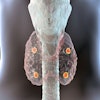
PET imaging has revealed a link between unusual brain activity and the severity of post-traumatic stress disorder (PTSD) in 9/11 responders due to their experiences at the World Trade Center in New York in 2001, according to a study published June 30 in Brain, Behavior, and Immunity -- Health.
In a pilot study, researchers analyzed PET brain scans of 9/11 responders with PTSD and found those who spent more time at the World Trade Center site had more severe PTSD symptoms and higher activity levels of a protein known for its association with neuroinflammation. The finding supports a strong body of evidence of increased risk of brain inflammation in PTSD, according to the researchers.
"To the best of our knowledge, our study is the first to report an association between [World Trade Center] environmental exposures and inflammation in the central nervous system," wrote lead author Sean Clouston, PhD, and colleagues of Stony Brook University in Stony Brook, NY.
Previous research has shown that World Trade Center responders are at increased risk of chronic PTSD and that an increasing number are presenting 20 years after the events with mild cognitive impairment. Yet little is known about the cause and development of mild cognitive impairment in 9/11 responders, according to the authors.
In this study, the researchers hypothesized that neuroinflammation might be a mechanism linking the experiences of 9/11 responders diagnosed with PTSD and evidence of cognitive impairment.
The researchers performed F-18 FEPPA PET brain scans using a 3T hybrid system (Biograph mMR, Siemens Healthineers) on 20 World Trade Center responders to measure the activity of a protein called translocator protein kDa-18 (TSPO), an established biomarker for neuroinflammation in neurodegenerative conditions.
Participants were mostly police officers between 48 and 64 years old. Half of the responders had mild cognitive impairment and half were cognitively unimpaired. The amount of time 9/11 responders spent at the World Trade Center site ranged from approximately 8.5 to 15 days.
The researchers did not observe significant differences in TSPO activity between responders with mild cognitive impairment and cognitively unimpaired responders. However, they did find significant associations between TSPO activity and the severity of PTSD symptoms. Also, longer exposure time at the World Trade Center site was associated with higher TSPO brain activity, according to the researchers.
"Our results revealed significant associations between PTSD symptom severity and higher [F-18]-FEPPA binding, predominantly in the hippocampus and frontal cortex, and longer [World Trade Center] exposure duration was associated with higher TSPO binding in the parietal cortex," the authors wrote.
While the study represents the first of its kind to measure TSPO activation at midlife in a cohort of World Trade Center responders with early mild cognitive impairment at midlife, it was limited in several ways, such as small sample size, the unique nature of the exposure, and the lack of a suitable external control group, the authors noted.
Nonetheless, the study is important because it suggests that increased TSPO binding was associated with PTSD symptom severity in responders with subsyndromal PTSD, the authors wrote.
"Results from this pilot study suggest that more research is warranted to understand the important role of neuroinflammation in highly exposed [World Trade Center] responders," the researchers concluded.





















